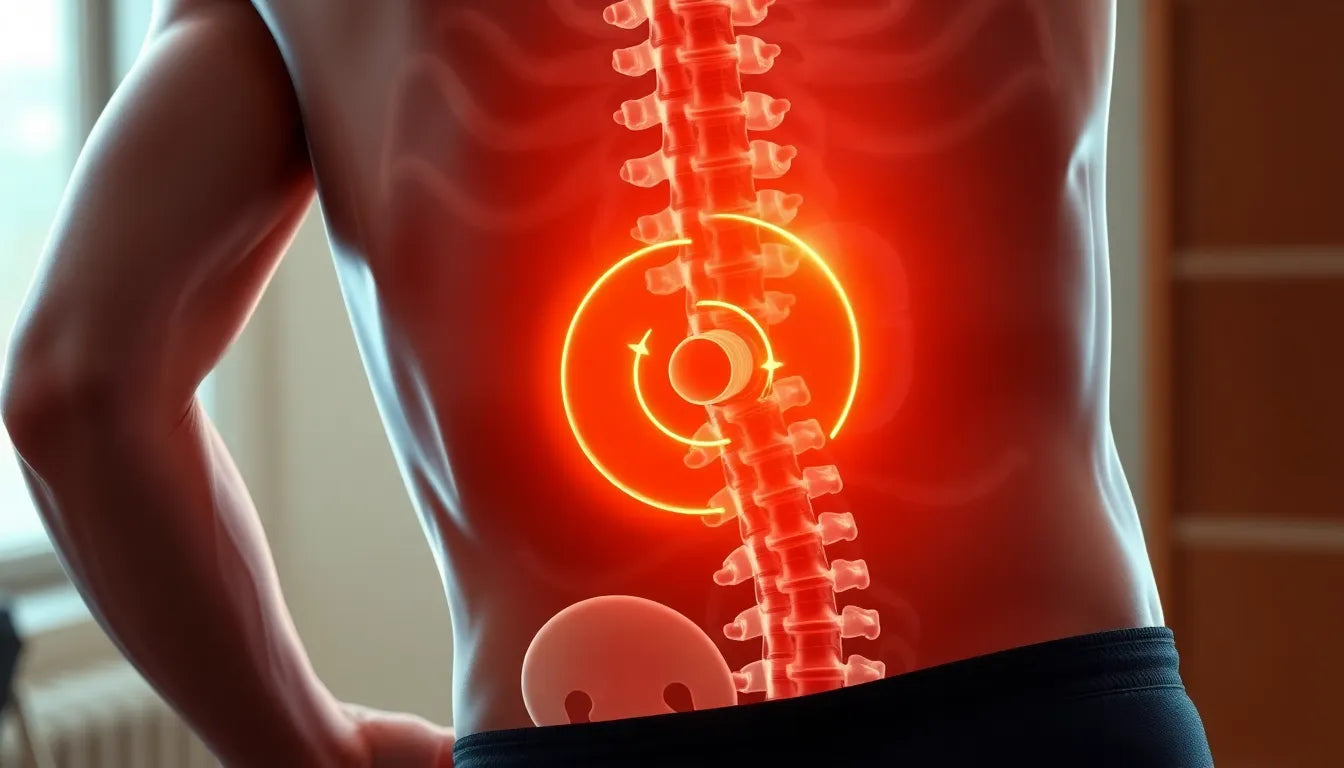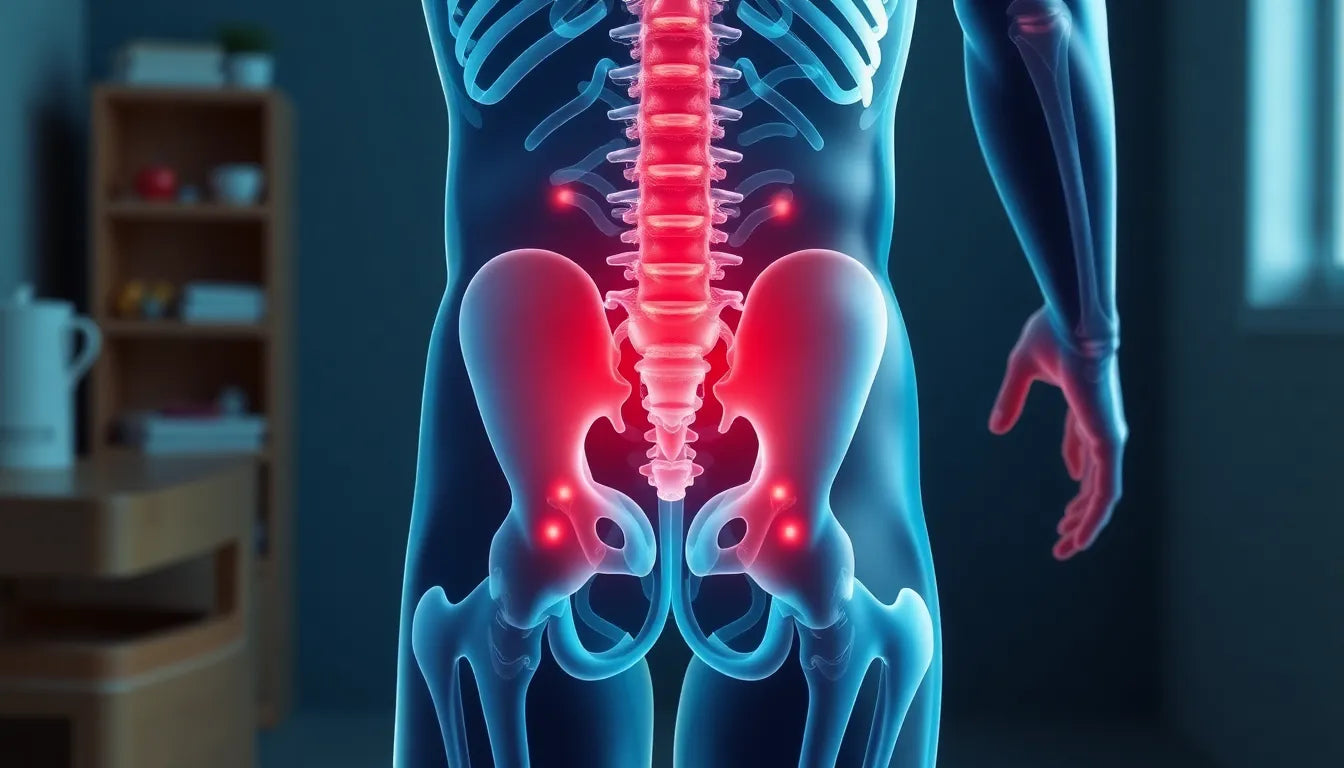Back pain is a common ailment that affects millions of people worldwide, often radiating to other parts of the body and causing discomfort in unexpected areas. One such area that can be affected is the hip, leading many to wonder: can a herniated disc be the culprit behind hip pain? This question is more than just a curiosity—it’s a crucial consideration for anyone seeking effective treatment and relief from persistent discomfort.
understanding herniated discs and their impact on the spine
A herniated disc occurs when the soft, gel-like center of a spinal disc pushes through a crack in the tougher exterior casing. This condition primarily affects the spine, particularly in the lumbar region, which is the lower part of the back. The herniation can lead to nerve compression or inflammation, causing pain that might not be limited to the back alone. This pain can travel along nerve pathways that extend towards the hip, leading to a possible connection between a herniated disc and hip pain.
The spine is a complex structure composed of vertebrae, discs, and nerves, all working together to support the body and facilitate movement. When a disc herniates, it can disrupt this harmony, leading to symptoms that extend beyond the immediate area of injury. Understanding this connection is vital for anyone experiencing hip pain, as it can guide them toward more accurate diagnoses and effective treatments.
the purpose of exploring the herniated disc-hip pain connection
The aim of this blog post is to delve into the relationship between herniated discs and hip pain. By differentiating this condition from other potential causes of hip discomfort, we can offer valuable insights into diagnosis and management strategies. This exploration is not just about identifying the source of pain but also about empowering individuals with the knowledge needed to seek appropriate care.
Throughout this post, we will examine how herniated discs can lead to hip pain, explore the nature and patterns of the discomfort, and discuss differential diagnosis methods. By understanding these elements, individuals can better navigate their symptoms and work with healthcare providers to find effective relief. Whether you're dealing with persistent hip pain or are simply curious about the connection, this exploration offers a pathway to greater understanding and, ultimately, relief.
understanding herniated discs and nerve pathways
A herniated disc in the lumbar spine can significantly impact nerve pathways, leading to a cascade of symptoms that might include hip pain. The lumbar spine is a critical region where nerve roots branch out to various parts of the body, including the hips. When a disc herniates, it can exert pressure on these nerve roots, causing irritation or inflammation. This pressure disrupts normal nerve function, potentially leading to pain that radiates from the lower back to the hip and even further down the leg.
The sciatic nerve, the largest nerve in the body, is often involved in cases of herniated disc-induced hip pain. Originating in the lower back, the sciatic nerve extends through the buttocks and down each leg. When a herniated disc compresses this nerve, it can result in a condition known as sciatica, characterized by sharp, shooting pain that travels along the nerve's pathway. This is why understanding the intricate network of nerves is crucial for identifying the source of hip pain and targeting it effectively.
nature and patterns of herniated disc pain
Herniated disc pain is often described as burning, stinging, or electric-shock-like, and these sensations can extend from the lower back to the hip and beyond. In addition to pain, individuals may experience numbness, tingling, or muscle weakness, depending on the specific nerves affected. This pain pattern is distinct and can help differentiate herniated disc issues from other causes of hip pain.
Another hallmark of herniated disc pain is its tendency to worsen with specific movements or positions. Activities that increase pressure on the lumbar spine, such as sitting for long periods, bending, or lifting, can exacerbate the pain. Conversely, lying flat or adopting certain positions may provide temporary relief. Recognizing these patterns is essential for both patients and healthcare providers, as it guides effective management and treatment strategies.
differential diagnosis: distinguishing hip pain sources
Accurately diagnosing the source of hip pain is crucial for effective treatment. While herniated discs can cause hip pain, it's important to distinguish this from pain originating directly from the hip joint. Hip joint pathology often presents as persistent groin pain, stiffness, and localized discomfort, which differs from the radiating pain of a herniated disc.
| Symptom | Hip Joint Pathology | Herniated Disc |
|---|---|---|
| Pain Location | Groin, localized | Low back, radiating to hip and leg |
| Pain Trigger | Movement of the hip joint | Standing, walking, sitting for long periods |
| Additional Symptoms | Stiffness, limited range of motion | Numbness, tingling, muscle weakness |
diagnostic approaches for accurate identification
To accurately diagnose the cause of hip pain, healthcare providers often rely on a combination of clinical examinations and imaging techniques. Physical exams can help assess the range of motion, identify pain triggers, and evaluate neurological function. Imaging tests, such as MRI or CT scans, provide detailed views of the spine and hip structures, revealing potential disc herniations or joint abnormalities.
Common diagnostic tests include the straight leg raise test, which can indicate nerve irritation, and the Patrick's (FABER) test, which helps assess hip joint pathology. By integrating these diagnostic tools, healthcare professionals can distinguish between hip joint issues and herniated disc-related pain, ensuring patients receive the most appropriate and effective treatment.
management and relief strategies for herniated disc pain
When dealing with herniated disc pain that radiates to the hip, a multifaceted approach to management and relief can be highly effective. Physical therapy is often a cornerstone of treatment, focusing on exercises that strengthen the muscles supporting the spine, improve flexibility, and reduce nerve pressure. A physical therapist can tailor a program to an individual's needs, ensuring it targets the specific areas affected by the herniated disc.
Medications may also play a role in managing pain and inflammation. Nonsteroidal anti-inflammatory drugs (NSAIDs) are commonly used to alleviate discomfort, while muscle relaxants can help reduce muscle spasms. In some cases, corticosteroid injections may be recommended to decrease inflammation around the affected nerves.
Beyond these interventions, lifestyle modifications can significantly impact symptom relief. Ergonomic strategies, such as adjusting posture and ensuring supportive seating, can reduce strain on the spine and help manage pain. Using ergonomic aids like lumbar supports and seat cushions can promote proper alignment and alleviate pressure on the lower back.
conclusion
Understanding the link between herniated discs and hip pain is crucial for effective diagnosis and treatment. By recognizing the distinct patterns of pain and employing appropriate management strategies, individuals can find relief from their symptoms. Accurate diagnosis is essential, as it guides the choice of treatments that can improve quality of life and prevent further complications.
Whether through physical therapy, medication, or ergonomic adjustments, addressing herniated disc pain requires a comprehensive approach. By working closely with healthcare providers, individuals can develop a plan that meets their specific needs and promotes long-term health and comfort.
frequently asked questions
Can a herniated disc heal on its own?
Yes, many cases of herniated discs improve over time with conservative treatment. Rest, physical therapy, and medications can support healing. However, some cases may require medical intervention, such as surgery, if symptoms persist or worsen.
How can I tell if my hip pain is from a herniated disc?
Herniated disc-related hip pain often presents as radiating pain from the lower back to the hip. If you experience this pattern, along with numbness or tingling, consult a healthcare provider for an accurate diagnosis.
When should I see a doctor for hip pain?
If your hip pain persists, worsens, or is accompanied by symptoms like numbness, weakness, or loss of bladder control, seek medical advice promptly. These symptoms may indicate a more serious condition requiring evaluation.
What are the best exercises for herniated disc pain?
Gentle stretching and strengthening exercises are generally recommended for herniated disc pain. Exercises that focus on core stability and flexibility can be beneficial. It's important to follow a program designed by a physical therapist to ensure safety and effectiveness.
Can ergonomic aids really help with herniated disc pain?
Yes, ergonomic aids can provide significant support and promote proper posture, reducing strain on the spine and alleviating pain. Lumbar supports, seat cushions, and adjustable chairs are examples of aids that can help manage symptoms effectively.
Sources
- Total Ortho Sports Medicine. "Understanding Herniated Discs and Hip Pain."
- StatPearls/NCBI Bookshelf. "Herniated Lumbar Disc."
- Barricaid's Blog. "Herniated Disc and Hip Pain: What You Need to Know."
- Integrated Chiropractic of Boca. "Chiropractic Insights on Herniated Discs and Hip Pain."
- Kevin Pauza, MD. "Differentiating Hip and Lumbar-Origin Pain."
- AANS (American Association of Neurological Surgeons). "Herniated Disc Overview."


















